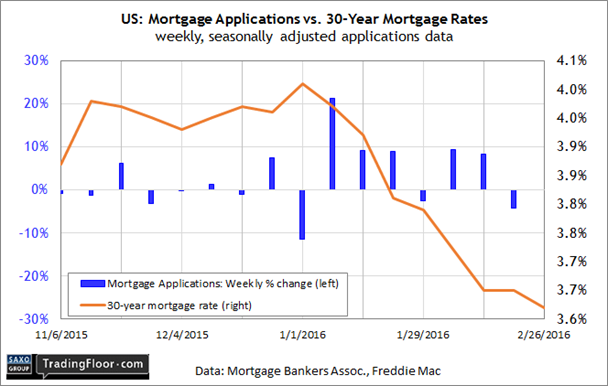- Spain is in focus today with its monthly update on unemployment
- Any rise in Spanish joblessness would suggest Europe’s recovery is faltering
- US mortgage applications should trend higher in the wake of lower mortgage rates
- Recent price rises and minimal inventory could hold back would-be home buyers
- Today's ADP update offers an early look at the US labour data for February
- The ADP update will give a crucial insight into the US macro trend
The European economy showing the strongest signs of recovery is under the microscope today with the release of unemployment data for Spain. Later, two reports will offer more details for profiling of the US macro trend in February. First up is the weekly mortgage numbers, followed by ADP’s estimate of private payrolls.
Spain: Unemployment Change (0800 GMT) The macro outlook for the eurozone has weakened lately, according to a variety of metrics. The manufacturing sector’s growth rate via Markit’s purchasing managers’ index, for instance, dipped to a one-year low last month. Meanwhile, deflation is back – consumer prices fell 0.2% in February vs. the year-earlier level.
But there’s also some good news to consider – unemployment for the single currency area ticked lower in January for the third straight month. It's a mild decline and painfully slow, but at least it's moving in the right direction.
Today’s update on Spain’s unemployment data will provide more perspective for deciding if the recent slide in the eurozone’s jobless rate is likely to continue in the months ahead. Spain, after all, continues to enjoy the strongest recovery among Europe’s main economies. The question is whether the softer numbers for some slices of the euro area pose a new challenge for Spain’s forward momentum.
Recent history still offers plenty of room for optimism for Europe’s fourth-largest economy. Yesterday’s PMI manufacturing update, for example, points to a robust growth rate. “Spanish manufacturers continued to rise above economic and political uncertainty in February, once again increasing output at a rapid rate and taking on extra staff at the fastest pace since the summer of 2015,” a Markit economist said.
Today’s update will tell us if a similar narrative applies to the country’s labour market overall via the hard numbers published by the government. Recent history has delivered solid gains, although the monthly numbers on changes in the ranks of the newly unemployed has been rocky lately. The population of unemployed workers rose by 57,200 in December, marking the first increase since last September.
It could be noise, of course. But in the current climate, another increase in Spain’s jobless population would feed the bearish view that Europe’s recovery is faltering.

US: Mortgage Applications (1200 GMT) Mortgage rates are trending lower in 2016, raising the possibility that we may see yields dip below the 2013 low for the 30-year national average – 3.35% – in the months ahead. In theory, this is good news for housing. But the source of lower rates – heightened worries about the economic outlook – leave room for doubt on whether lower financing costs will translate into a stronger housing market.
This week’s update on pending home sales certainly raises questions about where the housing market is headed as the spring buying season approaches. The National Association of Realtors on Monday reported that its index of sales that aren’t yet final fell 2.5% in January. “While January’s blizzard possibly caused some of the pullback in the northeast, the recent acceleration in home prices and minimal inventory throughout the country appears to be the primary obstacle holding back would-be buyers,” noted NAR’s chief economist.
Meantime, the view by way of the weekly numbers for new mortgage applications looks moderately encouraging. Five of the eight weekly reports so far in 2016 reflect higher demand. Last week’s update marked the first decline since late January. If today’s numbers reveal more red ink, the news will mark the first two-week drop this year. The hope is that the recent slide in mortgage rates will keep the market bubbling.

US: ADP Employment Report (1315 GMT) Today’s update from ADP will offer a crucial clue on the US macro trend in February. Although job growth has slowed recently, the expansion remains strong enough to argue that forward momentum is still healthy.
Today’s report is expected to deliver more of the same. Econoday.com’s consensus forecast sees ADP’s estimate of US private payrolls for February rising 185,000. That's a decent increase, but if the projection holds the labour market’s growth rate is headed for its slowest pace in four months and well below last December’s 267,000 surge.
Keep your eye on the year-over-year comparison for a clearer measure of the trend. For the moment, there’s a mild but simmering warning sign in the numbers via the slow descent in the annual increase. If today’s forecast for a monthly increase of 185,000 holds, the trend is set to weaken further, dipping below the 2% mark for the first time in over two years.
A softer growth trend is hardly fatal at this stage, assuming that we don’t dip below Econoday.com’s projection. Yet the likelihood that the annual change will show another round of deceleration in today’s update will serve as a reminder that the US recovery, which is approaching its six-year anniversary, is no spring chicken.

Disclosure: Originally published at Saxo Bank TradingFloor.com
